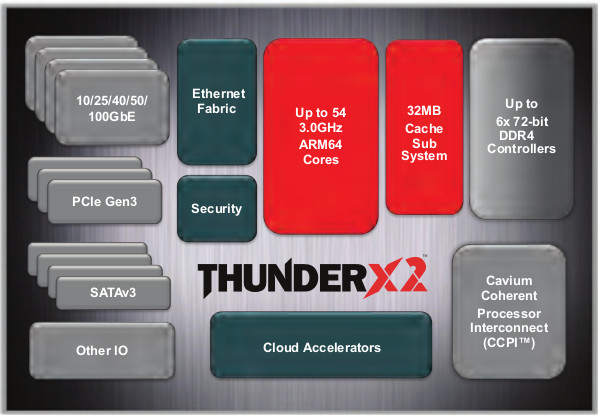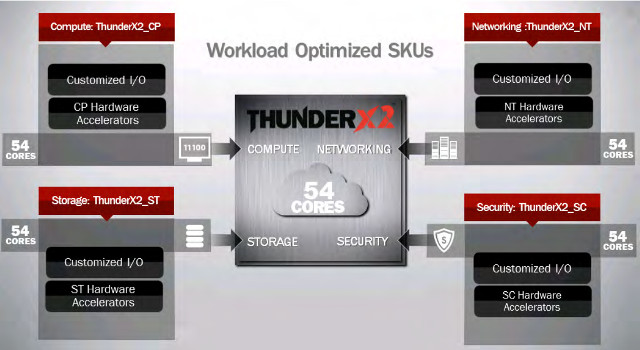Cavium announced their first 64-bit ARM Server SoCs with the 48-core ThunderX at Computex 2014. Two years later, the company has now introduced the second generation, aptly named ThunderX2, with 54 64-bit ARM cores @ up to 3.0 GHz and promising two to three times more performance than the previous generation.
Key features of the new server processor include:
- 2nd generation of full custom Cavium ARM core; Multi-Issue, Fully OOO; 2.4 to 2.8 GHz in normal mode, Up to 3 GHz in Turbo mode.
- Up to 54 cores per socket delivering > 2-3X socket level performance compared to ThunderX
- Cache – 64K I-Cache and 40K D-Cache, highly associative; 32MB shared Last Level Cache (LLC).
- Single and dual socket configuration support using 2nd generation of Cavium Coherent Interconnect with > 2.5X coherent bandwidth compared to ThunderX
- System Memory
- 6x DDR4 memory controllers per socket supporting up to 3 TB RAM in dual socket configuration
- Dual DIMM per memory controller, for a total of 12 DIMMs per socket.
- Up to 3200MHz in 1 DPC and 2966MHz in 2 DPC configuration.
- Full system virtualization for low latency from virtual machine to IO enabled through Cavium virtSOC technology
- Next Generation IO
- Integrated 10/25/40/50/100GbE network connectivity.
- Multiple integrated SATAv3 interfaces.
- Integrated PCIe Gen3 interfaces, x1, x4, x8 and x16 support.
- Integrated Hardware Accelerators
- OCTEON style packet parsing, shaping, lookup, QoS and forwarding.
- Virtual Switch (vSwitch) offload.
- Virtualization, storage and NITROX V security.
- Manufacturing Process – 14 nm FinFET
Just like for Cavium ThunderX, four revisions (SKUs) will be provided to match specific requirements, with all support 10/25/40/50/100GbE connectivity:
- ThunderX2_CP for cloud compute workloads. Used for private and public clouds, web serving, web caching, web search, commercial HPC workloads such as computational fluid dynamics (CFD) and reservoir modeling. This family also includes PCIe Gen3 interfaces, and accelerators for virtualization and vSwitch offload.
- ThunderX2_ST for optimized for big data, cloud storage, massively parallel processing (MPP) databases and Data warehousing. This family supports multiple PCIe Gen3 interfaces, SATAv3 interfaces, and hardware accelerators for data protection, integrity, security, and efficient data movement.
- ThunderX2_SC for optimized for secure web front-end, security appliances and cloud RAN type workloads. This family supports multiple PCIe Gen3 interfaces, as well as Cavium’s NITROX security technology with acceleration for IPSec, RSA and SSL.
- ThunderX2_NT optimized for media servers, scale-out embedded applications and NFV type workloads. This family includes OCTEON style hardware accelerators for packet parsing, shaping, lookup, QoS and forwarding.
The processor complies with Server Base Boot Requirements (SBBR), UEFI, ACPI support), and SBSA Level 2, and will support Ubuntu 16.04 LTS and later, Red Hat Early Access for ARMv8, SUSE SLES SP2 and later, CentOS 7.2 and later, and FreeBSD 11.0 and later.
Charbax interviewed the company at Computex 2016 in the 20-minute video below, where you can also see Gigabyte G220-T60 server with ThunderX with an Nvidia Tesla GPU (at the 7:20 mark) for “high performance compute applications”, and other servers based on the first generation ThunderX SoC.
It could not find when the SoC will be available. More details can be found on Cavium ThunderX2 product page.

Jean-Luc started CNX Software in 2010 as a part-time endeavor, before quitting his job as a software engineering manager, and starting to write daily news, and reviews full time later in 2011.
Support CNX Software! Donate via cryptocurrencies, become a Patron on Patreon, or purchase goods on Amazon or Aliexpress








Intel just released a benchmark of ThunderX vs Xeons: http://www.nextplatform.com/2016/05/31/intel-lines-thunderx-arms-xeons/
There’s also a recent preview article about a ThunderX based server at: http://www.servethehome.com/gigabyte-r120-t30-overview-first-cavium-thunderx-system/
IMO they’re somewhat intel-biased but they seemed quite pleased with this board, especially about IO.
@Bruce
That means Intel consider Cavium solution as a serious competitor then.
That’s a comparison to ThunderX, and ThunderX2 will be better, although I’m sure Intel new server SoCs will improve too.
@Fran Aquino
I like htop output on such servers 🙂 -> http://www.servethehome.com/wp-content/uploads/2016/05/OpenSSL-speed-htop-800×404.png
Hmm, this looks great. Such a system with 2 socket would be something i might consider in the future.
I have my servers in DCs so power consumption is a factor.
And the AMD Zens for servers are coming next year. Desktop Zen pretty soon 🙂
Good for the competition.
At long last – a true server-class ARMv8 board. I got to have that Gigabyte.